Welcome to our deep dive into the world of biostatistics, specifically focusing on data analysis techniques. Biostatistics, a critical field in modern healthcare and biological research, relies heavily on data analysis to make sense of complex biological data. This blog post will explore various techniques used in biostatistics data analysis, their applications, and their significance in the field. We'll delve into the intricacies of these methods, providing a comprehensive understanding of how they contribute to the broader field of biostatistics.
Understanding Biostatistics
Biostatistics, a discipline at the intersection of biology and statistics, plays a pivotal role in the healthcare industry. It involves the application of statistical techniques to biological phenomena. Researchers use these techniques to analyze a wide range of biological data, from genetic sequences to population health data.
Biostatistics provides a quantitative lens through which we can understand the complex web of biological processes. It helps us make sense of the vast amounts of data generated in biological research. Without biostatistics, we would be lost in a sea of numbers, unable to draw meaningful conclusions from our observations.
One of the key aspects of biostatistics is data analysis. This process involves inspecting, cleaning, transforming, and modeling data to discover useful information. Data analysis in biostatistics can be a complex process, given the nature of biological data. However, several techniques have been developed to facilitate this process. These techniques form the backbone of biostatistics and are essential for anyone involved in biological research or healthcare.
Descriptive Statistics in Biostatistics
Descriptive statistics is a fundamental technique in biostatistics. It involves summarizing and organizing data so that it can be easily understood. Descriptive statistics provides a snapshot of the data, highlighting key features and trends.
Measures of central tendency, such as the mean, median, and mode, are commonly used in descriptive statistics. These measures provide a summary of the data, giving an idea of the typical value. Measures of dispersion, such as the range, variance, and standard deviation, are also used. These measures provide information about the spread of the data, indicating how much variability there is.
Descriptive statistics is a powerful tool in biostatistics. It allows researchers to quickly and easily understand their data, providing a foundation for further analysis. However, descriptive statistics is just the beginning. There are many other techniques used in biostatistics data analysis.
Inferential Statistics in Biostatistics
Inferential statistics is another key technique in biostatistics. Unlike descriptive statistics, which focuses on summarizing data, inferential statistics involves making predictions or inferences about a population based on a sample of data.
Inferential statistics uses probability theory to draw conclusions. It involves estimating parameters, testing hypotheses, and making predictions. Common techniques include t-tests, chi-square tests, and analysis of variance (ANOVA).
Inferential statistics is a powerful tool in biostatistics. It allows researchers to make predictions about a population based on a sample of data. This is particularly useful in biological research, where it is often impractical or impossible to collect data from an entire population.
Regression Analysis in Biostatistics
Regression analysis is a statistical technique used to understand the relationship between variables. In biostatistics, regression analysis is often used to understand how different factors influence a particular outcome.
There are several types of regression analysis, including linear regression, logistic regression, and multiple regression. Each type of regression analysis has its own strengths and weaknesses, and the choice of which to use depends on the nature of the data and the research question.
Regression analysis is a powerful tool in biostatistics. It allows researchers to understand the relationships between variables, providing insights into the underlying biological processes. However, like all statistical techniques, regression analysis must be used with caution. It is important to understand the assumptions of the analysis and to check these assumptions before drawing conclusions.
Machine Learning in Biostatistics
Machine learning is a relatively new technique in biostatistics, but it is rapidly gaining popularity. Machine learning involves using algorithms to learn patterns in data and make predictions.
There are several types of machine learning, including supervised learning, unsupervised learning, and reinforcement learning. Each type of machine learning has its own strengths and weaknesses, and the choice of which to use depends on the nature of the data and the research question.
Machine learning is a powerful tool in biostatistics. It allows researchers to analyze complex data sets and make predictions. However, like all statistical techniques, machine learning must be used with caution. It is important to understand the assumptions of the analysis and to check these assumptions before drawing conclusions.
The Future of Biostatistics Data Analysis
The field of biostatistics is constantly evolving, and the techniques used for data analysis are no exception. New methods are being developed all the time, driven by advances in technology and the increasing complexity of biological data.
One of the most exciting areas of development is the use of artificial intelligence (AI) in biostatistics. AI has the potential to revolutionize the way we analyze data, allowing us to make sense of complex data sets and make predictions with unprecedented accuracy.
However, the future of biostatistics data analysis is not just about new techniques. It is also about improving existing techniques and making them more accessible. This involves developing user-friendly software and providing training and education to researchers and healthcare professionals.
Wrapping Up: The Power of Biostatistics Data Analysis Techniques
Biostatistics data analysis techniques are powerful tools that allow us to make sense of complex biological data. From descriptive statistics to machine learning, these techniques provide a foundation for understanding the complex web of biological processes. As the field of biostatistics continues to evolve, we can expect to see new and improved techniques for data analysis. These advances will undoubtedly enhance our ability to understand and improve human health.

